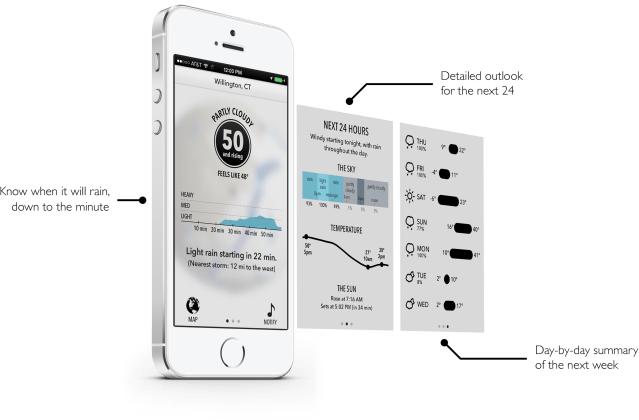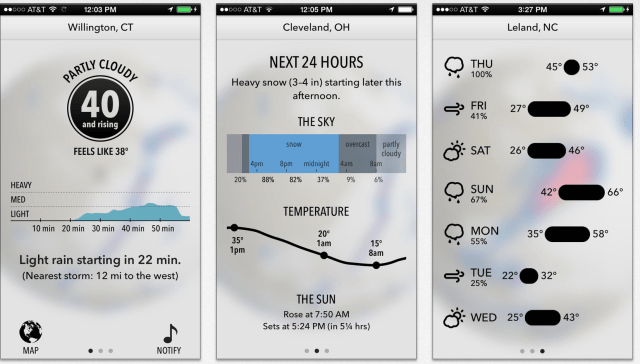
Dark Sky [1] , easily one of the better weather applications on iOS, rolled out an update today that expands its focus beyond rain predictions to become a more comprehensive weather app which offers both 24-hour and 7-day forecasts, global maps, and more. The app was also rewritten from scratch for iOS 7, the company notes.
For those unfamiliar, Dark Sky began its life as a Kickstarter project [2]  back in 2011, with a goal of offering “hyperlocal†weather information. That is, instead of just showing you what percent chance of rain there is in your area, Dark Sky looks at your exact location, then predicts the rain down to a minute. For example, it may tell you “Light rain starting in 20 min,†and offer a graph of what that future rain pattern will look like in terms of how light or heavy the rain will later become.
In addition, the app’s beautiful but simple design won it support and accolades from its user base, where it has consistently earned top reviews on the iTunes App Store. Its four-star rating in the past seems to only have been brought down by those who complain of battery concerns, or of accuracy. Of course, there may be times where Dark Sky misses the mark, but overall, the app is more “surprisingly accurate†than not, at least in my personal experience living in a humid locale, as well as in the majority of app store reviews.

And as for those battery concerns, co-creator Adam Grossman tells us that each time they’ve investigated complaints, it didn’t end up being the Dark Sky app that was the problem. After all, the app uses battery-draining GPS for location accuracy only when launched. For notifications, it uses cellular triangulation instead.
To date, Dark Sky has excelled its weather predictions, made possible by the backend weather service the company built called Forecast.io . This API, also open to third-party developers, offers current conditions, minute-by-minute, hour-by-hour and day-by-day forecasts, and more. Its data is sourced from a number of places, including NOAA (USA), worldwide METAR weather reports, the US Navy, the UK Met Office, the Norwegian Meteorological Institute, and others [3] . Aggregated together, the service provides a statistically more accurate forecast for any given location.
However, Dark Sky is currently only available in the U.S., U.K. and Ireland, due to the costs associated with licensing radar data. Fortunately, in the U.S., radar data is free, but the company has to pay recurring costs for U.K. data. But Grossman says he hopes that, in time, they’ll be able to afford expansions to other markets, like Canada, Australia, other parts of Europe, and Japan.
A number of third-party developers have also built apps powered by Dark Sky’s Forecast service, including Check the Weather, Poncho, Osito, Saga, Today Weather, QuickRoute, WeatherCaster and Weather Line. These steadily increasing API and data sales now pay for Dark Sky’s infrastructure, but the majority of the revenue the company earns comes from app sales, says Grossman. (The app is $3.99 on the App Store.)

Until now, Forecast’s complete feature set was never available within Dark Sky itself, which makes today’s update a notable release.
With the relaunch, the app has been rewritten from scratch for iOS 7, offering you an at-a-glance homescreen with the current temp, the “feels like†temp, and precipitation forecast. You can then swipe to see the 24-hour forecast, and the upcoming week. You can tap into a number of screen elements, including the current temperature to see wind, humidity, dew point, pressure, and visibility, or you can tap on the days of the upcoming week to see mini forecasts for each.
Meanwhile, a “maps†option also offers an animated globe featuring precipitation and temperatures, which you can zoom into and out of and spin around.
But what’s hard to describe is how fluid the app feels. It’s something you have to try for yourself to understand why so many tend to rave about Dark Sky’s design. (It’s impressive, too, since one-half of Dark Sky’s development team, Jay Laporte, doesn’t even own a cell phone, much less an iPhone. He only has an iPad.)Â
Grossman says the team decided to release the update to its current user base for free because they didn’t want to frustrate customers or support two apps.
“Even me, who’s a developer who lives off of people paying for my app, I got kind of pissed off at having to pay for all these apps again,†says Grossman of the ongoing pay-to-upgrade trend iOS developers try today in effort to squeeze additional revenue from their current users.
It’s also worth noting that Dark Sky, which has been profitable since shortly after launch, is entirely bootstrapped. The app hit half a million users last week, thanks in part to an App Store feature. The team doesn’t really do much in the way of advertising or marketing, relying mainly on word of mouth, says Grossman.
Even though today’s App Store has become a tough place to compete, something like Dark Sky shows that you can still be lean and become profitable.
Unfortunately, Grossman has some bad news for those who don’t carry iPhones.
“We will probably never make an Android application,†he says. “I can’t see making an app for a platform I just don’t use.†That being said, he was open to the idea of working with a partner on the “official†Android version of Dark Sky at some point in the future, though is not actively pursuing it at this time.

No comments:
Post a Comment